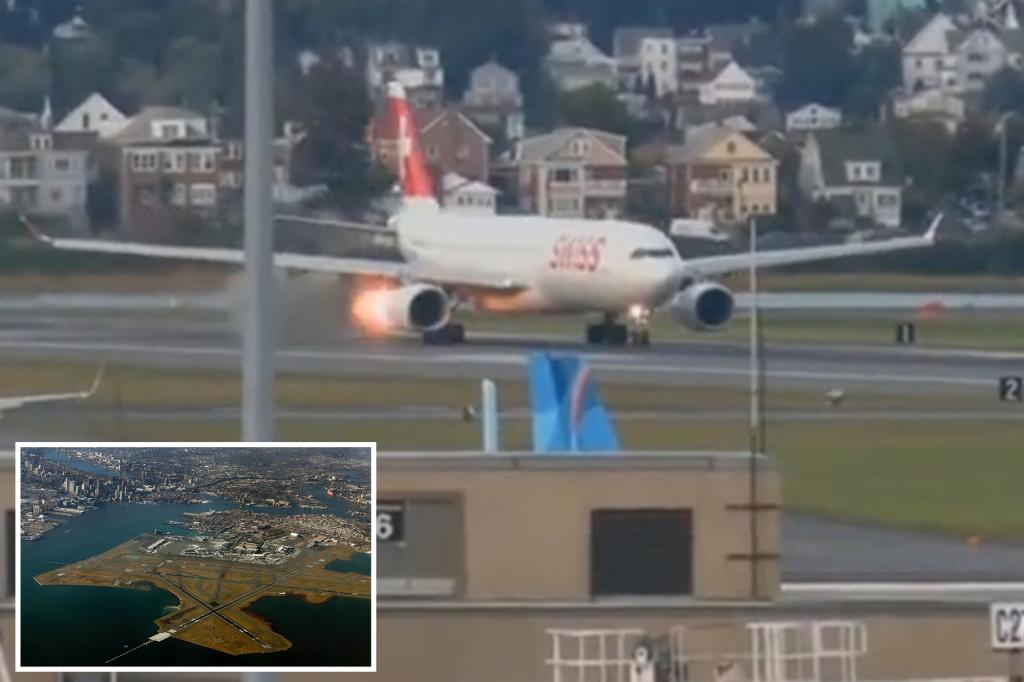Fiery Ordeal at Boston Logan: Swiss Air Takeoff Aborted as Engine Flames Shock Passengers
In a dramatic scene that unfolded Tuesday evening at Boston Logan International Airport, passengers aboard Swiss International Air Lines flight 55 experienced moments of terror when balls of fire suddenly erupted from the aircraft’s right engine during takeoff. The flight, bound for Zurich, Switzerland, had been gathering speed on the runway when the alarming incident occurred, forcing the pilot to make a swift decision that likely prevented a potential disaster. Video footage captured the frightening moment when flames shot out of the engine, illuminating the nighttime runway with bursts of orange fire. The quick-thinking pilot immediately aborted the takeoff procedure, bringing the aircraft to a controlled stop before it had left the ground. As the plane decelerated, it left behind a concerning plume of smoke trailing on the tarmac, a visible reminder of how quickly an ordinary departure can transform into a dangerous situation.
The response to the emergency was impressively swift, with airport safety protocols activating almost immediately. Emergency vehicles rushed to the scene within minutes of the aborted takeoff, prepared to address any escalation of the situation. The sight of fire trucks and emergency personnel surrounding the aircraft provided some reassurance to the understandably shaken passengers, who moments earlier had been settling in for their transatlantic journey. While such incidents are rare, they highlight the critical importance of the robust emergency response systems that major international airports maintain. In this case, the coordinated response helped ensure that a frightening incident didn’t develop into something more serious.
As a precautionary measure, Logan Airport officials implemented a temporary ground stop, halting all takeoffs and landings until the situation could be fully assessed and the affected aircraft cleared from the active runway. This decision, while causing some delays for other flights, reflected the airport’s commitment to prioritizing safety above all else. Despite the engine fire, the Swiss Air Lines plane maintained enough operational capacity to taxi to a gate under its own power, a positive sign that the damage was contained and systems remained functional. Local news outlet WHDH reported on the incident, capturing the attention of the Boston community and aviation enthusiasts concerned about flight safety.
For the passengers who had boarded flight 55 expecting a routine journey to Switzerland, the evening turned into an extended ordeal, though thankfully one without physical injuries. Swiss Air Lines worked to accommodate the disrupted travelers, arranging an alternative flight approximately five hours after the incident. While the delay was certainly inconvenient, many passengers likely felt a sense of gratitude that the engine malfunction was discovered on the ground rather than while airborne over the Atlantic Ocean. The airline’s ability to secure another aircraft and crew on relatively short notice demonstrated the aviation industry’s resilience and commitment to minimizing disruption even in challenging circumstances.
Perhaps the most remarkable aspect of this frightening incident is that despite the dramatic engine fire and emergency response, no injuries were reported among passengers, crew, or ground personnel. This fortunate outcome can be attributed to multiple factors: the pilot’s quick decision-making and skilled handling of the aircraft, the robust safety features built into modern commercial planes, the rapid response of airport emergency teams, and the orderly implementation of emergency protocols. Commercial aviation maintains an impressive safety record precisely because of these layered protections and the industry’s approach to treating every incident, no matter how minor, as an opportunity to enhance safety procedures further.
The Federal Aviation Administration (FAA) has launched an investigation into the incident, as is standard procedure for any significant aircraft malfunction or safety event. This investigation will likely examine the engine in detail, review maintenance records, analyze data from the aircraft’s systems, and interview the flight crew to determine exactly what caused the engine to emit flames during the takeoff roll. Such thorough investigations serve an essential purpose in the aviation industry, helping identify potential safety issues before they can affect other aircraft and implementing corrective measures across the fleet if necessary. While Swiss International Air Lines and the aircraft manufacturer will certainly conduct their own internal reviews, the FAA’s independent investigation provides an additional layer of scrutiny that helps maintain public confidence in air travel safety. As passengers continue their journeys and new flights depart from Boston Logan, this incident serves as a reminder of both the inherent risks of aviation and the extraordinary measures in place to mitigate those risks.


